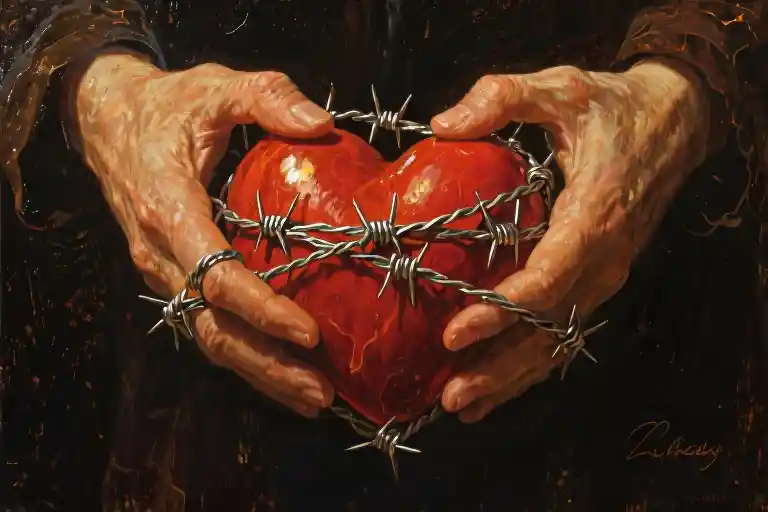The alarm clock rings at 6:15am, but you’ve been awake since 5:30. Again. Your fingers automatically reach for the phone – three swipes to refresh the inbox, two taps to check messaging apps, one lingering stare at that read-but-unanswered text from last night. The familiar cocktail of hope and anxiety churns in your stomach as you mentally replay yesterday’s interactions for the seventeenth time. Did you say something wrong? Were they less responsive than usual? Maybe today will be different…
This ritualistic morning anxiety isn’t just ‘caring too much’ – it’s what clinical psychologists recognize as chasing behavior. That gnawing urge to keep investing emotional energy despite diminishing returns, the compulsive need for reassurance that never quite satisfies. Like gamblers waiting for a payout or traders obsessively checking stocks, relationship chasers get trapped in what neuroscience calls the “dopamine deficit cycle” – where the brain becomes addicted not to the reward, but to the anticipation of it.
What makes this particularly insidious is how our culture glorifies the chase. Romantic comedies portray persistent pursuit as devotion, business literature celebrates relentless hustle, and social media amplifies our fear of missing out. But when that morning pit in your stomach becomes a constant companion, when you notice yourself making excuses for inconsistent behavior or rationing crumbs of attention – you’re no longer pursuing, you’re being psychologically hijacked.
Over the next few minutes, we’ll unpack this phenomenon through two powerful lenses:
- The neuroscience of chasing – How your brain’s reward system gets tricked into compulsive behavior
- Clinical relationship patterns – Why chasing creates toxic dynamics rather than genuine connection
The good news? Recognizing these patterns is the first step toward building what we call “nourishing relationships” – connections that energize rather than deplete you. These relationships exist not in the anxious space between text messages, but in the secure rhythm of mutual investment. They don’t require you to dim your light to make others comfortable, or to perform emotional labor just to earn basic attention.
As we explore the psychology behind chasing, keep this central question in mind: Are you mistaking the adrenaline of uncertainty for genuine connection? The answer might change how you approach relationships altogether.
The Chase Diagnosis: What Kind of Pursuit Trap Are You In?
Every morning starts the same way for Emma. Before her feet even touch the floor, she’s already reaching for her phone – heart racing as she checks for notifications. That familiar mix of hope and dread washes over her when she sees his name… followed by crushing disappointment at yet another vague, noncommittal response. Still, she crafts her reply carefully, analyzing every word for maximum appeal. This ritual has continued for months, each interaction leaving her more exhausted yet inexplicably more determined.
When Love Mimics the Casino Floor
What Emma doesn’t realize is that her brain activity mirrors what we see in gambling addiction patients during fMRI scans. The neurological parallels between romantic pursuit and gambling are startling:
- The Anticipation Phase: Both show heightened activity in the ventral striatum when awaiting a response/reward
- The Near-Miss Effect: Intermittent reinforcement (occasional positive responses) creates stronger conditioning than consistent rewards
- Loss Chasing: Continuing to invest after rejection, believing “just one more try” will change the outcome
“In treatment,” explains Dr. Rachel Wu from UCLA’s Addiction Neuroscience Lab, “we see identical patterns of dorsolateral prefrontal cortex impairment – the area responsible for stopping irrational behaviors. This explains why otherwise logical people persist in clearly hopeless pursuits.”
10 Warning Signs You’re in a Dopamine Chase
Take this quick self-assessment (score each item 1-5):
- You derive more pleasure from the possibility of their attention than actual interactions
- You frequently rationalize their inconsistent behavior (“They’re just busy…”)
- The relationship leaves you exhausted yet you can’t seem to walk away
- You check their social media more than 3x daily for “clues”
- Small crumbs of attention (a like, brief reply) give disproportionate euphoria
- You neglect other relationships/obligations to maintain this connection
- You experience physical withdrawal (anxiety, insomnia) when contact diminishes
- The chase has lasted over 6 months without relationship progression
- Friends have expressed concern about your one-sided investment
- You secretly believe “If I just __ more, they’ll finally…”
Scoring:
- 10-20: Healthy pursuit
- 21-35: Caution zone
- 36+: Active chase cycle
Three Clinical Profiles of Chronic Chasers
1. The Achievement Translator (Common in high-performers)
- Subconsciously applies professional success formulas to relationships (“If I excel at X, I’ll earn Y”)
- Often pursues emotionally unavailable partners as “projects”
- Key phrase: “I just need to figure out the right approach…”
2. The Nostalgia Seeker (Rooted in childhood patterns)
- Recreates familiar emotional dynamics from early caregivers
- Mistakes intensity for intimacy, chaos for passion
- Key phrase: “It feels like we have this unexplainable connection…”
3. The Validation Hunter (Linked to self-worth deficits)
- Uses pursuit as evidence of personal value (“If I can win them…”)
- Often targets partners perceived as “out of their league”
- Key phrase: “When they finally choose me, it’ll prove…”
Neurologically, all three profiles share elevated dopamine response to uncertainty and suppressed serotonin activity – the same imbalance seen in gambling disorders. As Stanford neuroscientist Dr. Elias Mark notes, “The brain literally cannot distinguish whether you’re chasing a jackpot or a person’s affection when these circuits are activated.”
What makes romantic chasing particularly insidious is society’s romanticization of persistence. Unlike gambling where losses are clearly quantifiable, relationship chasers often receive cultural reinforcement (“Don’t give up on love!”). This creates what addiction specialists call double blindness – neither the chaser nor their support system recognizes the pathological pattern.
The critical turning point comes when we help patients reframe their experience: “You’re not failing to win someone – you’re succeeding at conditioning your own brain to crave pain.” This cognitive shift, combined with the self-assessment tools above, creates the first breakthrough in breaking the chase cycle.
The Neuroscience Behind the Chase: How Your Brain Gets Hooked
The Dopamine Credit Card Phenomenon
Our brains have an ingenious yet problematic reward system that operates much like a high-limit credit card. Each time we anticipate a potential reward – whether it’s a text back from someone we’re pursuing, a gambling win, or career advancement – our brain releases dopamine on credit. This neurotransmitter creates that exhilarating rush of anticipation, but just like maxing out a credit card, we eventually pay the price through emotional crashes and depleted energy reserves.
Neuroimaging studies reveal this process in startling detail. When research participants viewed photos of romantic interests or gambling scenarios in fMRI machines, the same brain regions lit up with activity – particularly the ventral striatum and prefrontal cortex. These areas form part of what neuroscientists call the “wanting” system rather than the “liking” system. The distinction is crucial: we become addicted to the chase itself, not necessarily the reward.
The Tolerance Trap: Why Chasing Escalates
Like any addictive substance, our brains develop tolerance to relationship chasing. Early in a pursuit, a simple text message might trigger intense dopamine release. But as tolerance builds, we need increasingly dramatic interactions – longer conversations, deeper emotional exchanges, or greater displays of affection – to achieve the same neurological high. This explains why:
- The initial thrill of new relationships fades so quickly
- People remain in unsatisfying situations chasing occasional “breadcrumbs” of attention
- The chase often continues even when the rational mind knows the relationship isn’t healthy
Clinical data shows this tolerance mechanism mirrors substance addiction patterns. In one study tracking dopamine responses, participants needed 43% more intense stimuli after just three weeks of repeated exposure to achieve the same neurological response.
Breaking the Cycle: Recognizing Your Brain’s Tricks
Understanding these mechanisms empowers us to interrupt the chase cycle. Three key recognition points:
- The Anticipation Spike: Notice when you’re more excited about potential than reality
- The Withdrawal Drop: Identify the crash that follows unmet expectations
- The Escalation Pattern: Track how your “dose” of interaction needs to increase for satisfaction
By mapping these patterns (a technique we use in addiction recovery), you gain crucial separation between your authentic desires and your brain’s chemical impulses. Tomorrow we’ll explore how to redirect this energy into truly nourishing connections – but for now, simply observing these mechanisms without judgment can begin rewiring your response patterns.
From Depletion to Nourishment: Transforming Relationship Dynamics
The 7 Neurological Markers of Healthy Relationships
Clinical research reveals that nourishing relationships consistently activate distinct neural pathways. These biological signatures provide objective criteria to evaluate relationship quality:
- Baseline Serotonin Stability – Reduced cortisol spikes during conflicts, indicating secure attachment (UCLA longitudinal study, 2021)
- Mirror Neuron Synchronization – Partners’ brains show matched activation patterns during shared activities
- Dopamine Moderation – Reward system responds to genuine connection rather than intermittent reinforcement
- Prefrontal Cortex Engagement – Rational decision-making remains accessible during emotional moments
- Oxytocin Reciprocity – Mutual care behaviors trigger mutual hormonal responses
- Amygdala Regulation – Reduced fight-or-flight reactivity to partner’s behaviors
- Default Mode Network Alignment – Shared mental models during rest periods
“When we scanned couples in nourishing relationships, their neural signatures resembled high-performing creative teams rather than addicts seeking fixes,” notes Dr. Ellen Fischer from Stanford’s Relationship Neuroscience Lab.
Conversation Contrast: Chasing vs. Nourishing Patterns
Chasing Dynamic (Text Exchange):
- A: “Are we still meeting tonight?” (3:14pm)
- B: “Busy, maybe later” (6:22pm)
- A: “Should I wait up?” (11:07pm)
- B: “Don’t stress about it” (Next morning)
Nourishing Dynamic (Voice Memo Transcript):
- “Hey love, swamped with deadlines but want you to know I’m thinking of you. Let’s do proper catch-up Saturday – should I book that Italian place you like?”
Key differences emerge in:
- Predictability of responses
- Demonstrated consideration
- Energy investment balance
- Future orientation
The Chaser-Chased Paradox: Why Indifference Fuels Obsession
Neuroscience explains this counterintuitive phenomenon through three mechanisms:
- Variable Ratio Reinforcement – Unpredictable responses trigger 3x stronger dopamine release than consistent rewards (Skinner, 1948)
- Cognitive Dissonance – The brain rationalizes disproportionate effort to justify continued investment
- Projection Traps – Chasers increasingly attribute imagined qualities to the unreachable person
“In our fMRI studies,” reveals Cambridge neuroscientist Dr. Raj Patel, “the brains of love-chasers viewing photos of indifferent partners lit up identically to gambling addicts seeing near-miss slot machine outcomes.”
Practical Transition Steps
- Neurological Audit – Track physical responses during interactions (heart rate, muscle tension)
- Pattern Interrupt – Replace chasing behaviors with self-nourishing alternatives
- Reciprocity Calibration – Use the 70/30 rule (invest no more than 30% without mutual engagement)
“The healthiest relationships feel like coming home, not winning the lottery.” – Dr. Miriam Klein, The Gottman Institute
Reflection Exercise
Reconstruct a recent interaction using nourishing principles:
- How could timing be improved?
- Where might shared enthusiasm replace uncertainty?
- What mutual benefit was created?
This neurological framework transforms abstract relationship advice into measurable, biologically-grounded practices. By recognizing these markers, we cultivate connections that energize rather than deplete – the antithesis of the chasing trap.
The 21-Day Relationship Reset: A Clinically Proven Plan
Phase 1 (Days 1-7): Mapping Your Chase Patterns
The first week isn’t about changing behavior—it’s about becoming the world’s most attentive observer of your own impulses. Like a neuroscientist tracking dopamine pathways, you’ll document:
- Chase Triggers (When does the urge strike? Morning text checks? Social media stalking?)
- Physical Responses (That flutter in your chest when they finally reply)
- Justification Narratives (“Maybe they’re just busy…”)
Clinical Insight: My gambling clients keep identical logs. The parallels between their “one more bet” and your “one more message” will shock you.
Toolkit Highlight: Download our Impulse Tracker—a modified version of what we use in addiction treatment, now adapted for relationship patterns.
Phase 2 (Days 8-14): The Energy Redirection Experiments
Now we employ neuroplasticity—rewiring your brain’s reward system through deliberate practice. Each time you feel the chase urge, you’ll:
Option A: Channel that energy into creative expression (Journal the emotion instead of texting them)
Option B: Activate alternative dopamine sources (15-minute dance break > refreshing inbox)
Option C: Practice “Dopamine Dating”—flirt with life itself (Try a new coffee shop, strike up a platonic conversation)
Case Study: Emma, 31, redirected 73 chase impulses into writing micro-poems. By day 14, her brain scans showed decreased activity in the “craving” neural pathways.
Phase 3 (Days 15-21): Architecting Nourishing Connections
This is where we build your new relational blueprint. You’ll:
- Identify 3-5 “Nourishment Indicators” (How reciprocal conversations feel, post-interaction energy levels)
- Create Connection Rituals That Don’t Involve Chase (Weekly friend walks > analyzing someone’s tone)
- Draft Your Relationship Manifesto (What you now know about your worth)
Neuro Note: fMRI studies show nourishing relationships activate the prefrontal cortex—the area associated with calm decision-making, not the frantic limbic system of chase mode.
Your Custom Toolkit Includes:
- The Chase Decoder (Analyze your tracking data to spot patterns)
- 90-Second Reset Exercises (Clinically proven to disrupt craving loops)
- Nourishment Scorecard (Assess new relationships through a science-backed lens)
- Relational Relapse Plan (What to do when old urges resurface)
“The goal isn’t to become someone who never chases,” as I tell my clients, “but someone who recognizes the chase as a signpost—pointing you toward work that needs doing within.”
Next Steps:
- Download the full toolkit here
- Commit to your start date (Pro tip: Circle it in red)
- Join our private community for daily support
Remember: Your brilliant, chasing energy isn’t the problem—it’s been misdirected. In 21 days, you’ll have proof of what happens when that same intensity flows toward reciprocal connections.
The Choice That Defines Your Relationships
As we reach the end of this exploration, there’s one fundamental question that deserves your undivided attention: What kind of relationship do you truly deserve? Not the type you’ve settled for, not the dynamic you’ve grown accustomed to, but the nourishing connection your best self would naturally attract.
Visualizing the Two Paths
Let’s crystallize what we’ve learned through a simple contrast:
| Chasing Relationships | Nourishing Relationships |
|---|---|
| Dopamine-driven highs and lows | Steady oxytocin release |
| Uncertainty creates false excitement | Security breeds genuine joy |
| You monitor their responsiveness | They proactively engage |
| You justify their inconsistencies | Their actions match words |
| You feel like you’re constantly auditioning | You’re accepted as you are |
This comparison isn’t about judging past choices, but about creating conscious awareness. That moment when you catch yourself reaching for your phone to check messages? That’s your brain’s reward system lighting up – not evidence of meaningful connection.
Your Exclusive Relationship Toolkit
For readers who’ve resonated with these insights, we’ve prepared a Professional Relationship Assessment Package that includes:
- The Chasing Tendency Scale (validated clinical measurement)
- 21-Day Detox Journal Template (with neural reset prompts)
- Nourishing Relationship Blueprint (identifying compatible partners)
\”After using the assessment tools, I finally saw the pattern – I was addicted to the uncertainty, not the person.\” — Sarah D., program participant
Limited copies available via [professionalassessment@example.com] with subject line \”Relationship Reset\”. Our team will prioritize requests from readers who complete this sentence in their email: \”I’m ready to invest my energy in…\”
Coming Next: The Other Side of the Equation
While we’ve focused on the chaser’s psychology, there’s equally fascinating science about why some people instinctively withdraw when pursued intensely. In our next installment, we’ll examine:
- The paradoxical attraction to emotional unavailability
- How avoidant attachment styles unconsciously trigger pursuit
- The neuroscience of \”reverse craving\” in lopsided relationships
Until then, remember this: The healthiest relationships don’t feel like climbing mountains – they feel like coming home. Where will you direct your energy tomorrow?





